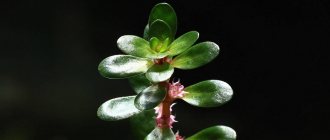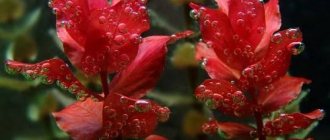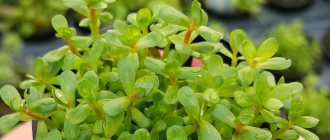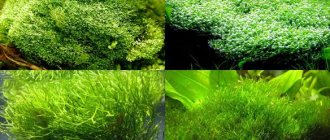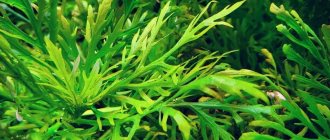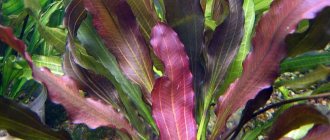Large-stamen rotala: maintenance and breeding
Photo: Rotala macrandra
Photo: Rotala macrandra
Homeland - India. One of the most beautiful long-stemmed plants. The magnificent pink color of the thin, shiny oval leaves makes this plant a real decoration for any aquarium. Typically, the maximum length of rotala stems reaches 20-25 cm. The plant should be placed in the foreground or on the side shelf of the aquarium. Rotala macrostamen is one of the most whimsical tropical aquatic plants. The water temperature for rotala should be high, optimal 27-30 °C. At a temperature of 26 °C and below, its growth stops, young leaves quickly become smaller, and old ones disintegrate. Rotala does not tolerate hard water (hardness greater than 6°). The optimal water hardness for this plant is 2-4°. Such water has a neutral or slightly acidic reaction, which suits Rotala quite well. It very poorly tolerates the presence of many chemicals in water, in particular sodium ions, so the addition of table salt and baking soda is completely undesirable. Lighting for large stamen rotala should be very bright. The plant should be placed as close to the light source as possible, under direct rays. Direct sunlight for 2-3 hours a day is very beneficial. However, it is quite possible to limit yourself to artificial lighting. In this case, it is imperative to use a combination of LB type fluorescent lamps to create intense diffused light and incandescent lamps to increase the proportion of red-orange radiation. Using only strong incandescent lamps can cause the plant to overheat and is associated with high energy costs. The duration of daylight should be 12-14 hours, but the rotala must be protected from algae. Blue-green algae are especially dangerous for it. The root system of rotala is very poorly developed. Additional roots are formed on the stems spreading near the surface of the water. Despite this, the plant must be planted in the ground. Left to float, rotala grows very slowly and gradually becomes smaller. At the slightest deviation of water characteristics from the optimal ones, such floating unrooted stems quickly die. The soil for rotala should be sufficiently nutritious, but not too silty. It is useful to add some clay and peat to the new soil. The best soil is taken from an old aquarium. Considering the delicate structure of the rotala root system, not very fine river sand should be used for the substrate, the layer thickness of which should be no more than 2-3 cm
Mineral fertilizing should be done very carefully, since the plant reacts poorly to the slightest excess of salts in the water. The concentration of mineral fertilizers for rotala should be 2-3 times less than recommended for other plants
In addition, it is better to do mineral fertilizing not once, but two or three times a week, naturally reducing the dose. Rotala propagates under artificial conditions, like all long-stemmed plants, by stem cuttings. The cuttings should be 7-10 cm long, since the shorter ones begin to grow very slowly. A cutting taken from the middle of the stem must have a formed side shoot. Rotala should be handled as carefully as possible, as it is very sensitive to touch, especially to the touch of fingers. When transplanting, the plant should be exposed to air as little as possible. When growing rotala at low water levels, you should not allow it to go out into the air, since the ground shoots of the plant lose their decorative effect. In addition, in terrestrial conditions the plant blooms, which also leads to a deterioration in its appearance.
Reviews and advice for beginners
Although Indica Rotala appeared relatively recently among aquarists, it has already caused a lot of controversy. Some consider it a “plant for the lazy,” others consider it a finicky herb. However, their discussions provide invaluable assistance to beginners. Here's what they recommend:
- Large herbal plants with a variety of species require fertilizers, and Indica Rotala is sensitive to copper, boron, and iron content. Before feeding, you need to remove the bushes from the aquarium.
- Choose artificial light in the red-orange range.
- Shoots that escape the water column begin to bloom, while those that have faded lose their decorative effect. They should be pinched at the surface of the water.
- If the Indica leaves appear larger and brighter near the water surface than at the bottom, CO2 should be added.
Beginners need to be careful and careful when using fertilizers - Indica Rotala is very sensitive to excess micro and macroelements.
The unassuming universal hydrophyte Indica Rotala is increasingly interested in landscapers. Not only the decorative and cleansing functions of the grass attract their attention, but also the affordability of the price.
Benefits for the aquarium
This is a graceful, actively growing herb. It looks impressive as a plant on its own, emphasizing the structural depth of the background of the aqua zone, and can be used to create aesthetically attractive underwater compositions.
From the editor: Formalin (Formaldehyde) for the treatment of aquarium fish
Rotala affects the hydrochemical characteristics of the aquatic environment:
- absorbs nitrogenous and other compounds;
- saturates water with oxygen;
- becomes a haven for bacterial flora, which is a natural aquarium filter.
It creates favorable conditions for the life of fish and other inhabitants of the artificial biocenosis. Fry and adults can hide in the thickets; the foliage serves as an additional source of food for some of them.
Reproduction
Rotala, like all long-stemmed plants, is characterized by propagation by stem cuttings. The length of the cuttings should be at least 7-10 cm, otherwise they will grow extremely slowly. If you take a cutting from the middle part of the stem for propagation, make sure that it has formed a side shoot.
When performing any manipulations with the rotala, do it very carefully. Its delicate leaves do not react well even to the slightest touch of fingers.
Therefore, when replanting, try to minimize the time the plant spends in the air.
If you are growing rotala in a container with a low water level, make sure that its top is not above the surface. Ground shoots, once exposed to air, will quickly lose their decorative properties. Also, once out of the water, the plant may bloom, which will also not have the best effect on its appearance.
Recommendations for placement
Rotala rotundifolia looks good in aquariums in the background and middle ground. Can be used to decorate side walls. When choosing neighbors, it is recommended to give preference to aquatic plants with large leaves.
You should not plant single plants, they are not very decorative. It is proposed to give preference to group plantings. Then dense groups of plants are formed.
Rotala is characterized by a high growth rate. To stimulate the formation of beautiful side shoots, you can cut off the upper part of the main stem. As soon as the plants begin to lose their decorative properties, they need to be trimmed. You can create a new group composition from cut shoots. It is also necessary to rejuvenate old plantings in which the stems are exposed.
Appearance
The leaves of rotala red-leaved are ovoid in shape with wavy edges and reach sizes up to 5 cm in length and 4 cm in width, located on a long stem opposite each other. The underside of the leaf is painted purple, but the color of the upper side varies from red to green. Rotala macrostamen has slightly branched, long stems, growing vertically and reaching up to 20-25 cm in length. The rhizome is creeping with a large number of leaf buds. The plant blooms with small pink flowers.
Large-stamen rotala is a real decoration of the aquarium. The lacquered, oval leaves of purple color make this variety of rotala red-leaved one of the most beautiful among aquarium plants. Plants should be placed in groups on the side or foreground of the aquarium. Just the groups should not be too dense, otherwise the lower leaves will be in the shadow of the side shoots.
Types of aquarium rotala
The genus Rotala includes many hygrophytic plants. They differ in the color of flowers, leaves and other features.
Rotala Walliha
The species R. wallichii, although demanding regarding conditions in the aquarium, is attractive for its decorative effect. Its thin, erect shoots up to 35 cm high give almost no lateral branches. They are densely covered with needle-shaped leaves about 15 mm long, the color of which varies from pale green to crimson. Sometimes it is possible to achieve a particularly spectacular golden-pink hue.
Rotala Wallich.
Indian
Rotala indica is found naturally in India, China, and Indonesia. Its reddish lanceolate leaves, which take on a bluish tint in bright light, are distinguished by their opposite arrangement. Their width does not exceed 3 mm. With photodeficiency, the stems become elongated, the leaves become smaller and pale, the plant loses its attractiveness, becoming a banal representative of the aquarium flora.
Round-leaved
This type of plant is often identified with rotala indica, believing that this is its terrestrial form. The plants are similar in many ways, but represent different taxonomic groups. The round-leaved variety (R. rotundifolia sp. green) is distinguished by a slightly larger distance between the stem nodes. Its oval leaves, about 12 mm long, are colored rich green. Red flowers may appear on the surface of the stems. If you pinch the top, the shoots will begin to actively branch, creating picturesque thickets.
Nanyenshan
Similar to Rotala Wallich. Its long (up to 2.5 cm) narrow leaves are collected in several pieces in closely spaced whorls. In good light, the stems are located horizontally, almost parallel to the ground surface, and the apical foliage acquires an amber or golden-red hue. With an inclined orientation, the shoot plant can be placed in the central part of the aquarium.
Macrandra
Large-stamen rotala (R. macrandra) is characterized by increased sensitivity to changes in housing conditions. The arrangement of the leaves is opposite, the color ranges from pinkish-olive to deep red. The flowers are pink with long stamens rising above the receptacle.
Macrandra.
There are several subspecies of makrandra:
- Red. The largest-leaved of the rotals. The leaves are oval, up to 3 cm in length.
- Green. Less whimsical. The leaf blades are smaller, soft green on the upper side and pinkish on the lower side.
- Narrow-leaved. Differs from green in smaller width of foliage (up to 10 mm). Branches well.
- Tiger. Characterized by pronounced venation of leaves. The color is red or pinkish, the veins are lighter.
- Mini. The stem is 10-15 cm long, covered with small elongated leaves.
Several hybrids have also been developed.
Hipuris
R. hippuris grows in Japan and is found in decorative ponds in Taiwan. Coastal specimens rise above the ground by half a meter. The stem is whorled, the leaves are needle-shaped, light green or golden in color. The nodes and apical part may acquire a light or rich pink tint. Plants are planted in a cluster, most often in the background and on the sides.
Perls
Pearls (Rotala pearls) grow in the wetlands of Singapore, but are rarely found in aquariums. The leaves are small, 5-7 mm, curved, juicy green on top, pinkish or violet on the reverse side. The lateral edges curl towards each other at an angle, giving the leaves a pointed shape. The species is not characterized by rapid growth, and with insufficient care it becomes similar to the round-leaved variety.
Pusila
Rotala pusilla grows in Japan, Brazil, and African countries. The stem is dense, tall (up to 40 cm), erect. The leaves are narrow, pointed, the ends are slightly curved downwards. There is a pronounced resemblance to indica, but the color of the foliage is predominantly yellowish, the stem is red or light brown. For rapid growth, good care is needed.
Rotala Pusila.
Bangladesh
The variety is widespread in the waters of Bangladesh, as reflected in the name. She is relatively unpretentious. Used for planting in the middle ground against a background of aquarium greens.
The stems of this hygrophyte are densely leafy, about 20 cm high. The leaf blades are thin, 1-1.5 mm wide, mostly light green. Bright lighting promotes pinking of shoots and apical leaves.
Butterfly
Rotala sp. Butterfly is a compact plant of bright crimson or red color, often considered as a form of makrandra. It got its name because the leaves resemble butterfly wings. They are thin, wavy, shiny, oval in shape with a pointed edge. They are located in nodes in pairs opposite each other. The average height of the shoots is 15 cm, so they can be placed in the foreground.
Mexican goias
Distributed in tropical and warm temperate regions throughout the world. It is a weed of rice plantations. The stem of this variety is creeping or erect and branches well. The leaves are reddish-green, narrowly lanceolate, in the above-water environment they become wider (up to 5 mm), in whorls of 3-5 pieces. The flowers are solitary, formed in the leaf axils.
Mexican goyas.
How to distinguish them from each other?
Rotala macrandra
is a red, long-stemmed aquarium plant with the largest leaf of all macrandra hybrids. May be found as rotala macrandra red. The leaf size can reach 3cm in length and 2cm in width. The most difficult to maintain of all types of macrandra. In this forum thread you can see what it might look like: Rotala makrandra.
Rotala macrandra 'Green'
– this rotala acquires a yellow-red color only at the surface of the water under illumination of 1 watt/l and provided that the concentration of nitrates in the aquarium water is below 10 mg/l. Therefore, most often in aquariums this rotala has green leaves and a brown stem. The leaf size is smaller than that of ordinary rotala makrandra - about 2 cm in length and 1 cm in width. This rotala is much less whimsical than the usual macrandra and it will not be difficult for a novice aquarium plant lover to successfully grow it. Her photo is at the beginning of the article.
Rotala macrandra 'Green Narrow Leaf'
– this rotala is often confused with the previous rotala, since they are very similar. The only difference is the width of the leaves. Rotala green angustifolia has a leaf width of about 5 mm. In all other respects, it is the same as the green makrandra rotala.
Rotala macrandra 'Narrow Leaf'
is a new and still rare species of rotala in the aquarium hobby, which can be found on sale as Rotala macrandra 'Florida' or Rotala 'Magenta'. Like the usual rotala makrandra, this is a red aquarium plant. Outwardly, it is similar to Ludwigia brevipes, but has more delicate leaves and stems like all macrondra rotals. Of all the makrandras, this rotala is the most versatile in terms of decorating an aquarium in the aquascape style. And perhaps as it spreads among aquarists, it will become a popular plant in aquascaping
Rotala rotundifolia
Family loosestrife - Lythraceae. Homeland - Southeast Asia.
Rotala rotundifolia or Indian rotala (Rotala indica) is a long-stemmed plant that can grow both in an aquarium and in a humid greenhouse. It is relatively rare among aquarists. Individual branches of rotala grown in water look unsightly. On the stems, reaching 20 - 25 cm in the aquarium, delicate light green elongated leaves about 1 cm long sit in pairs. However, the large bush looks very impressive and goes well with large-leaved plants. Place the rotala closer to the side walls. It grows in the aquarium all year round.
It is best to keep rotala in a tropical aquarium at temperatures above 24 °C. At lower temperatures, this plant, which develops slowly in water, practically stops growing. The water should be soft or moderately hard. Rotala feels best in water with a total hardness of less than 6°, and if the hardness exceeds 12°, it soon dies. The active reaction of water is preferably neutral or slightly acidic. In alkaline water, the plant develops unsatisfactorily. It is necessary to keep the aquarium clean and regularly change 1/5 - 1/4 of the water volume. The appearance of turbidity in the water leads to a deterioration in the appearance of the plant and a slowdown in its growth.
Lighting should be moderately bright. With a lack of light, the rotala stretches out and looks weak and pale. Excessive lighting can lead to the appearance of algae, which is harmful to the plant. Lighting must be selected individually, taking into account that the plant can withstand moderate shading. You can focus on the color of young leaves, which under favorable conditions acquires a pinkish tint. Illumination with incandescent lamps in combination with diffused natural light or lighting with fluorescent lamps is very useful. The duration of daylight hours should be about 12 hours.
Rotala grown in an aquarium has a poorly developed root system. The plant can be planted in the ground - then it takes on a more spectacular appearance, or it can be left floating in the water column. A plant grown in soil has enough natural sludge to feed it. A floating plant that receives nutrition only from water develops more slowly.
As already mentioned, rotala can be successfully grown in a paludarium and in a wet greenhouse. A part of the stem taken from the aquarium is planted in soil covered with water. In such conditions, rotala forms elastic above-water shoots with round glossy leaves and blooms. Aerial shoots grow very quickly under favorable conditions.
Features of rotala content
For active growth and preservation of decorative features, special conditions must be created.
Requirements for an aquarium
Preference should be given to containers with a volume of 100 liters or more. Aeration and filtration equipment should be located away from them.
The water should be soft (5-10°F), fresh and unturbid, acidity should be low or neutral. The temperature is maintained at +24…+28°С. When it decreases, growth slows down; further decrease leads to the death of the plant. Change 15-25% of the water volume weekly. Carbon dioxide supply required.
Intense lighting is required, the brightness of which is selected individually. In dim light it becomes very stretched and loses color saturation. Its excess can lead to the appearance of algae, which will cause the sprouts to die. Light mode – at least 10 hours of backlight in addition to 2 hours of natural light.
Priming
The composition of the soil is not particularly important; natural siltation is enough for nutrition. The grass develops well in a floating state (without rooting). Although the roots are weakly anchored in the soil, rooted specimens grow faster and look more impressive.
Landing
The prepared cuttings are placed in aquarium water and left for several days. When the roots are 0.5 cm long, the sprouts can be planted. They are placed in groups of 10-20 copies, placing clay lumps under the roots. Select the most illuminated areas with minimal flow, mainly in the background and on the sides. For better fixation in the sand, the roots are pressed with gravel.
Rotala indica: contents, reproduction, description, photo
Lighting when keeping rotala should be moderately bright. With a lack of light, the rotala stretches out and looks weak and pale. Excessive lighting can lead to the appearance of algae, which is harmful to the plant. Lighting must be selected individually, taking into account that the plant can withstand moderate shading. You can focus on the color of young leaves, which under favorable conditions acquires a reddish tint. Illumination with incandescent lamps in combination with diffused natural light or lighting with fluorescent lamps is very useful. The duration of daylight hours should be about 12 hours.
Rotala kept in an aquarium has a poorly developed root system. The plant acquires a more spectacular appearance when planted in the ground. But you can also leave it floating in the water column. The plant does not need fertilizing. Rotale grown in soil is completely sufficient to feed natural sludge. A floating plant, receiving nutrition only from water, develops correspondingly more slowly.
Rotala rotundifolia can be successfully grown in a paludarium or in a humid greenhouse. A part of the stem taken from the aquarium is planted in soil covered with water. In such conditions, rotala forms elastic above-water shoots with round glossy leaves and blooms with small pink flowers. Aerial shoots grow very quickly under favorable conditions. Rotala requires high humidity, high water and air temperatures (26-30 °C), and bright lighting. A plant taken from a greenhouse can be immediately placed in an aquarium. After a short break, it continues to grow, forming shoots with elongated leaves.
Description
Rotala indica is a plant native to Southeast Asia and the Caucasus. At home it grows up to 30 cm. The arrangement of sessile red-brown leaves is opposite. In some cases, the leaves may take on a purple tint. Their length is 1 cm, width is 0.3 cm. Side shoots grow quickly, shading the lower branches, which leads to bare stems and pale leaves. Regular thinning, trimming and side lighting will help avoid this.
NAYAS AQUARIUM PLANT CONTENTS REPRODUCTION PHOTO.
Conditions of detention
Rotala indica is an unpretentious plant. The main thing is to monitor the water parameters. Comfortable temperature - 24 degrees, hardness 5-6. If the water temperature is low, the plant stops growing; if the hardness increases (above 12), it dies. Acidity - 6-7. In an alkaline environment, indica develops slowly. Loves moderate lighting. In low light it stretches out, but looks faded. When adjusting the intensity, you should focus on the color of young leaves. If conditions are good, they turn reddish. Excessive darkening or lightening indicates “unhealth.” It is good if incandescent lamps are combined with exposure to diffuse sunlight.
Planting and propagation Rotala indica feels excellent not only when planted in the ground, but also floating freely in the water. However, when kept in the ground it grows much faster. Indian rotala is usually bred in a greenhouse. Propagated by cuttings or by separating root shoots. When planting cuttings in soil lightly covered with water, it forms elastic sprouts with shiny leaves above the surface
. Intense light, high humidity and a temperature of at least 26 degrees are important for indica. After the rotala indica grows stronger, it is transplanted into the aquarium. It is better to place the plant closer to the back and side walls of the home pond. A group “flowerbed” looks much more impressive than planting with individual branches. Video: cutting rotala indica
BACOPA MONNIER CONTENTS REPRODUCTION DESCRIPTION PHOTO.
Features of aquarium maintenance
When growing in an aquarium, certain conditions must be observed.
The temperature of the environment affects its growth. It develops actively at temperatures above +24 °C, but practically does not grow in colder liquids. Indica grows poorly in an alkaline environment, and when water hardness is above 12 °dH it quickly dies.
Lighting
It is ideal to use three types of lighting: solar, fluorescent and incandescent. Brightness, preferably moderate, in the range of 60-100 Lm/l and a duration of approximately 8-12 hours. Active vegetation and the reddish color of the plant’s leaves indicate proper lighting. Lamps placed below and behind will emphasize the effectiveness of Indica.
Priming
Take a mixture of fine gravel, peat, clay and a small amount of silt. A nutrient layer about 3 cm thick is obtained.
Grass planted in the ground uses the necessary substances from a thin layer of silt. Although the root system is quite weak, it develops faster and looks more impressive than a floating plant.
Editorial: Cockatoo Apistogram
Thinning
Old shoots are removed in a timely manner. About 5-6 cm from the top of the stem is plucked off and placed in the right place. Soon the roots will sprout and become stronger in the soil. If the Indica has grown excessively, the excess stems can be carefully and easily pulled out.
Planting, care, reproduction
To get a new Indian Rotala plant, it is enough to cut cuttings with 3–4 internodes and let them float freely on the surface of the water. When roots appear, immediately plant the cutting vertically in the ground, otherwise Indica will stunt growth.
03:01
Indian rotala (Rotala indica)
08:03
Added to the herbalist Rotala H»Ra
06:32
Indian rotala haircut (rotala indica)
Planting with several stems looks more impressive than a single plant. Even from one cutting, a full-fledged bush is obtained by pinching the top of the shoot. The grass grows quickly; within a month a fluffy tussock appears. Periodic thinning will protect against shade and leaf loss. Once a month, it is enough to cut out the bare stems and leave suitable cuttings for seedlings.
How to properly care for a plant
To feed rotala, you can use mineral fertilizers in small quantities. Some varieties are demanding of iron-containing fertilizers, which are necessary for color intensity. To prevent these algae from growing too much and filling the entire aquarium, you need to periodically thin out and trim them.
Important! These aquatic plants do not like external interference as they are quite fragile. In order not to damage the leaves and stems, you should not install aerators and filters near them, or touch them with your hands again.
The most sensitive to such interference are the large-stamened rotala and the Wallich rotala.
Rotala grows quickly, gradually exposing part of the stem at the bottom, so as necessary, plants need to be updated and replaced with young specimens.
Reproduction and planting
Rotala is propagated by cuttings. To do this, you need to cut off part of the stem (no more than 7-10 cm) and plant it in nutritious soil. After a few days, the cutting will adapt to the new conditions and take root
It is important at this time to maintain the temperature within 27-30 degrees and provide the plant with bright lighting. If the cuttings are planted in a greenhouse, it is necessary to maintain high ambient humidity
It is worth noting some rules that must be followed when replanting a plant:
Rotala is sensitive to touch
She does not tolerate frequent touching with fingers, so it is better to work with special tweezers, gently squeezing the plant; If it is transplanted or propagated in aquarium conditions, it is important to prevent the rhizome from coming into contact with air; Rotala is afraid of blue-green algae thickets. They cover the leaves, depriving them of vital light.
Useful video: How to trim Indian Rotala
Description and distribution of rotala
The forms cultivated in aquariums are herbaceous perennials, growing up to 35 cm in height. Their stems are thin, long, and knotty. From each node, oblong petioleless leaves are formed. Old leaves, shaded by the apical ones, die off, and the lower part of the stem becomes bare. The color of the plant varies from soft green to reddish purple.
Above-water shoots may bloom. Flowers of regular shape, solitary or collected in apical inflorescences. They form dry fruit boxes filled with small seeds.
The natural habitat of the rotala is tropical and temperate latitudes. It grows on river shallows and wetlands. Some species are common in southeast Asia, Georgia, Armenia, Azerbaijan and other Transcaucasian countries.
general description
There are a huge number of species of Rotala found in nature. Naturally, this plant has certain similar features and characteristics:
- There are both annual and perennial varieties of Rotala.
- Stems are bare. Depending on the species, they can be erect, creeping or floating.
- The leaves are collected in whorls. They have a round or needle shape. Color can vary from light green to purple.
- Flowering is pink or white.
After flowering, a fruit is formed in the form of a capsule, which contains seeds that are ovoid in shape and brown in color.
How to properly keep rotala in an aquarium
Most rotals are very picky about their living conditions.
The necessary conditions
In order for rotals to show themselves in all their glory, they should create a certain environment.
Did you know? Rotals look most beautiful in group plantings.
When decorating an aquarium, it is recommended to place them closer to the walls. Since they are often used to decorate background or middle backgrounds, backlighting is used for these light-loving plants.
Temperature
When keeping rotala, it is necessary to ensure a temperature regime of the aquatic environment of at least +24 °C. Lower temperatures lead to slower plant growth.
Lighting
Rotala prefers moderately bright lighting. With a lack of sunlight, it loses its beautiful appearance - it stretches out and turns pale. The plant normally withstands only slight shade. In favorable light conditions, rotala leaves have pinkish or golden hues.
Daylight hours should be approximately 12 hours. In winter, when daylight is short, it is necessary to provide artificial lighting using a fluorescent lamp or incandescent lamp, which is placed next to the aquarium.
You can also decorate your aquarium with the help of plants such as cabomba, salvinia, pistia floating, glossostigma, nymphoides, elodea, echinodorus.
Water requirements
The water in the aquarium must be soft or slightly hard (gH no more than 6). If the hardness is exceeded to 12, the rotala may wither. The required acidity of the aquatic environment must be neutral or low acidity.
Editorial: Girardinus
This aquatic plant does not tolerate an alkaline environment well. Rotala loves clean water, so changes should be done regularly (20–25% of the total volume of water), filtration and aeration should be ensured. Dirty water has an adverse effect on the development and appearance of the plant.
It is necessary to ensure that algae does not appear in the water - they spoil this plant. You should also monitor the water level: it should be sufficient for the rotala to be completely submerged.
Priming
Rotala is completely undemanding when it comes to soil selection. Moreover, having a weak root system, it can develop in the water column. But it is worth considering that rotala planted in the ground has a more beautiful appearance, since it receives more nutrients from the soil than simply floating in the water.
Pebbles with the addition of peat or clay are excellent for soil. For a weak root system of the plant, about 3 cm of soil in the aquarium is sufficient.
Content
In our area, rotala is not as common as abroad. This is due to the fact that domestic aquarists are reluctant to learn about new plant species. In addition, the plant is quite fastidious in care.
The suitable temperature range for comfortable maintenance of rotala ranges from 22 to 28 degrees Celsius. Moreover, the higher this indicator, the better the rotala grows.
You will also need to get powerful lighting. The richer the light, the redder the plant's leaves will be. This shade makes it decorative and unique, and noticeably distinguishes it from the general background of the aquarium. Daylight hours should last at least 12 hours. You can allow sun exposure for a few hours. If the rotala begins to lose color and weaken, these are the first signs of a lack of light.
The aquatic environment in which the plant is kept must be soft. The presence of peat is required (as fertilizer, or you can use a peat filter). Every 2 weeks you should replace about 30% of the water with fresh water. It is also important to maintain the water level so that the plant does not protrude to the surface.
In order to achieve good growth and development of rotala, you will need natural soil with a nutritional component. The best option would be small pebbles with the addition of clay or peat. A layer of a few centimeters is enough for the plant’s rhizomes to take root.
If the rotala begins to lose color and weaken, these are the first signs of a lack of light.
Rotala does not require any additional feeding (except peat) if the soil is sufficiently nutritious. It is possible to use mineral fertilizers, but the dosage for it should be half that for the rest of the flora.
The plant should be placed away from the filter. Otherwise, the current may pull it out of the ground or damage delicate and fragile leaves.
We recommend reading the article: Is Lomariopsis lineata moss or fern?
Features of care
Rotala should be in water with a temperature of 24-30C. If the environment is below the required temperature, the plant stops growing. Rotala is completely undemanding when it comes to acidity levels. However, water not exceeding a hardness level of 12dGH is recommended. For normal growth, iron and nitrates must be present in the water. Otherwise, the leaves of rotundifolia rotundifolia will become smaller, paler, and may die. For good growth, you need to ensure the supply of carbon dioxide.
The plant has special requirements for water purity. There should not be any suspensions; in this case, filtration and partial water replacement help.
For 12 hours, the plant should be under light, bright or moderate. If there is not enough light, the leaves will lose their color and the stems will begin to stretch. If there is too much lighting, algae and microorganisms will begin to develop, the proximity of which rotala does not tolerate.
A moderately silted substrate, preferably fine-grained, is suitable as soil for the plant. This will provide food for the rotala. It has a poorly developed root system. The plant responds well to complex fertilizers in liquid form.
Growing and care
Rotala Wallicha is better known as a submerged rather than fully aquatic plant. This demanding amphibian only grows when given proper care. You should be especially careful when transplanting into new soil and during pruning. Among rotals, this type is one of the most delicate to handle.
The main difficulty in keeping it is to achieve a red tint to the leaves. Depending on the lighting and hydrochemical parameters, the color of the leaf blades varies from pale pink to red, lilac and purple.
General care recommendations:
The plant is grown both rooted in the ground and freely floating in water. The color of the leaves and the shape of the bushes will vary depending on the conditions. Aquarists have different opinions about the optimal planting plan for this plant. Western lovers of underwater aquaflora tend to place it in groups in the central part. Domestic ones prefer to distribute them evenly in the background. Since the rotala can be shortened, it is also suitable for the frontal area
In any case, it is important to take into account that the plant does not branch well, so it is advisable to plant it in a group, separately from all the plants in the aquarium.
- They are placed in a tank of any volume, but the plant achieves its best decorative qualities at a water level of no higher than 20 cm.
- Rotala Wallich should be placed only in a tropical aquarium, the temperature of which does not fall below 22 ° C. In cool water, plant growth stops.
- Almost all rotals grow well in humid greenhouses or paludariums.
- The average growth rate is up to 20 cm monthly.
An indicator of proper care is the coloring of the leaf plates. In an unfavorable environment, they acquire a dull olive tint.
Optimal indicators of the aquatic environment
The water change rule also applies to Rotala Wallich. Weekly it is necessary to refresh up to 1/5 of the total volume.
Recommended hydrochemical parameters:
- temperature - 22-28°C;
- carbonate hardness - 1-10° kH;
- pH - 5.5-6.5;
- general hardness - 2-4° dH.
Lighting requirements
Like all crops with reddish leaf blades, Rotale Walliche requires intense lighting. Lack of light leads to stretching of leaves and leveling of the decorative shade.
Despite the fact that natural light is beneficial for the life of the plant, it is advisable to avoid direct exposure to sunlight. Otherwise, the leaves will become covered with algae. The recommended daylight hours are 12 hours or more.
Incandescent lamps with a power of 15 to 40 W depending on the volume of the tank, and fluorescent type LB with a power of 0.5 W per 1 liter are used as artificial lighting devices.
Soil quality
Due to the fact that the rhizome is poorly developed, the level of siltation in the soil does not play a determining role. The optimal substrate will be river sand of medium fraction, laid out in a layer of 3 cm.
The need for feeding
Rotala Wallicha does not take well to the introduction of chemical additives. But since in a closed aquarium system the concentration of necessary nutrients does not level out on its own, it is advisable to add udo.
Recommended concentrations:
phosphates - from 1 to 2 ppm;
nitrates - from 20 to 25 parts per million;
CO2 - from 15 to 25 mg/l.
Long-stemmed
Arthraxon hisp >
Arthraxon hispidus has been used as an aquarium plant relatively recently.
It is very widespread in nature. Arthraxon hispidus is native to Southeast Asia, Japan and northern Africa.
In Asia, Arthraxon hispidus grows in rice fields as a weed and can reach a height of 30-50 cm. There it is called water bamboo.
- More about Arthraxon hispidus
- 11502 views
Elatine Americana
Elatine Americana is a new and still quite rare aquarium plant.
Sometimes called Microparea Minima.
Elatine Americana appears to be a very fragile plant. The stem is thin, delicate, highly branched. Small leaves sit opposite or whorled on it. The leaf blades are very narrow, oblong, similar to spruce needles. Painted Elatine Americana a beautiful bright green.
- More about Elatine Americana
Bacopa sp. Pantanal
Bacopa sp. Pantanal is a delicate, neat, small plant. On a thin stem without petioles, rounded leaves sit crosswise in pairs. The color of the leaf blades is light green. The central vein is clearly visible.
The content of Bacopa sp. Pantanal is not pretentious. Grows well in water from soft to medium hardness with a neutral reaction. Nutritious soil, the application of microfertilizers and the supply of CO2 to the water help maintain successful growth and appearance of the plant.
- Read more about Bacopa sp. Pantanal
Bacopa salzmanii
Externally, Bacopa salzmanii differs among its relatives. First of all, the color of the leaves. The color of the leaf blades is dark, from brown to deep purple.
The leaves clearly show a pattern of veins that are reddish in color. With high intensity lighting and adequate nutrition, these reddish lines become more pronounced.
A CO2 supply can be helpful, but is not necessary for growing Bacopa salzmanii in an aquarium.
- Read more about Bacopa salzmanii
Bacopa sp. Japan
Bacopa sp. Japan is a small plant of soft green color.
Unlike all other species of Bacopa sp. Japan grows not vertically, but at an angle. The stem is highly branched and the plant may simply look like a large bush.
The content of Bacopa sp. Japan is pretty simple. Water of medium hardness with a reaction from slightly acidic to neutral. Temperature does not matter much; it can rise in the range of 18-30 o C.
- Read more about Bacopa sp. Japan
Bacopa colorata
Now a number of new, not yet very common plants are appearing in the aquarium hobby.
Bacopa colorata is one of them.
The origin of Bacopa colorata is unknown, it may even be an artificial hybrid.
Externally, Bacopa colorata resembles the long-known Bacopa caroliniana. They are united, however, by the arrangement of leaves on the stem, which is common to all bacopas. The leaves are arranged crosswise in pairs.
Then the differences begin.
- Read more about Bacopa colorata
- 12702 views
Ludwigia repens “Mesakana”
Ludwigia repens “Mesakana” is a new and even rare variation of Ludwigia repens.
Ludwigia repens “Mesakana” was first mentioned by K. Kasselmann in 2010 (Kasselmann, Christel (2010): Aquarienpflanzen. 3rd edition. – DATZ Aquarienbuch, Ulmer Verlag.)
She assumed it was a hybrid grown in Mexico.
Ludwigia repens “Mesakana” is a very ornamental plant.
The leaves are crosswise opposite on small petioles, broadly elliptical in shape.
- More about Ludwigia repens “Mesakana”
Pogostemon sp. Kimberley
Pogostemon sp. Kimberley is a relatively new aquarium plant.
According to some data, the homeland of Pogostemon sp. Kimberley is Southeast Asia.
But as an aquarium plant, it began to be used quite recently and not yet very widely.
This may be due to the relatively high cultivation requirements of Pogostemon sp. Kimberley.
- More information about Pogostemon sp. Kimberley
Rotala sp. Singapore
Rotala sp. Singapore is still quite a rare plant for our aquariums.
Rotala sp. Singapore is a bright representative of the numerous galaxy of Rotala.
Rotala sp. Singapore grows well in a wide range of conditions, making it an attractive plant for both experienced aquarists and beginners.
Water from soft to medium hardness with a neutral reaction. The supply of CO2 will help maintain the desired acidity of the water.
- Read more about Rotala sp. Singapore
Distribution area
Like many aquarium plants, Rotala Wallich comes from Southeast Asia.
It is found everywhere in rice fields and wetlands of India, China, Thailand, Laos, Taiwan and Vietnam. When American aquarists brought the culture to the United States, it quickly spread throughout the world. It is especially popular in the Scandinavian countries and the Netherlands.
